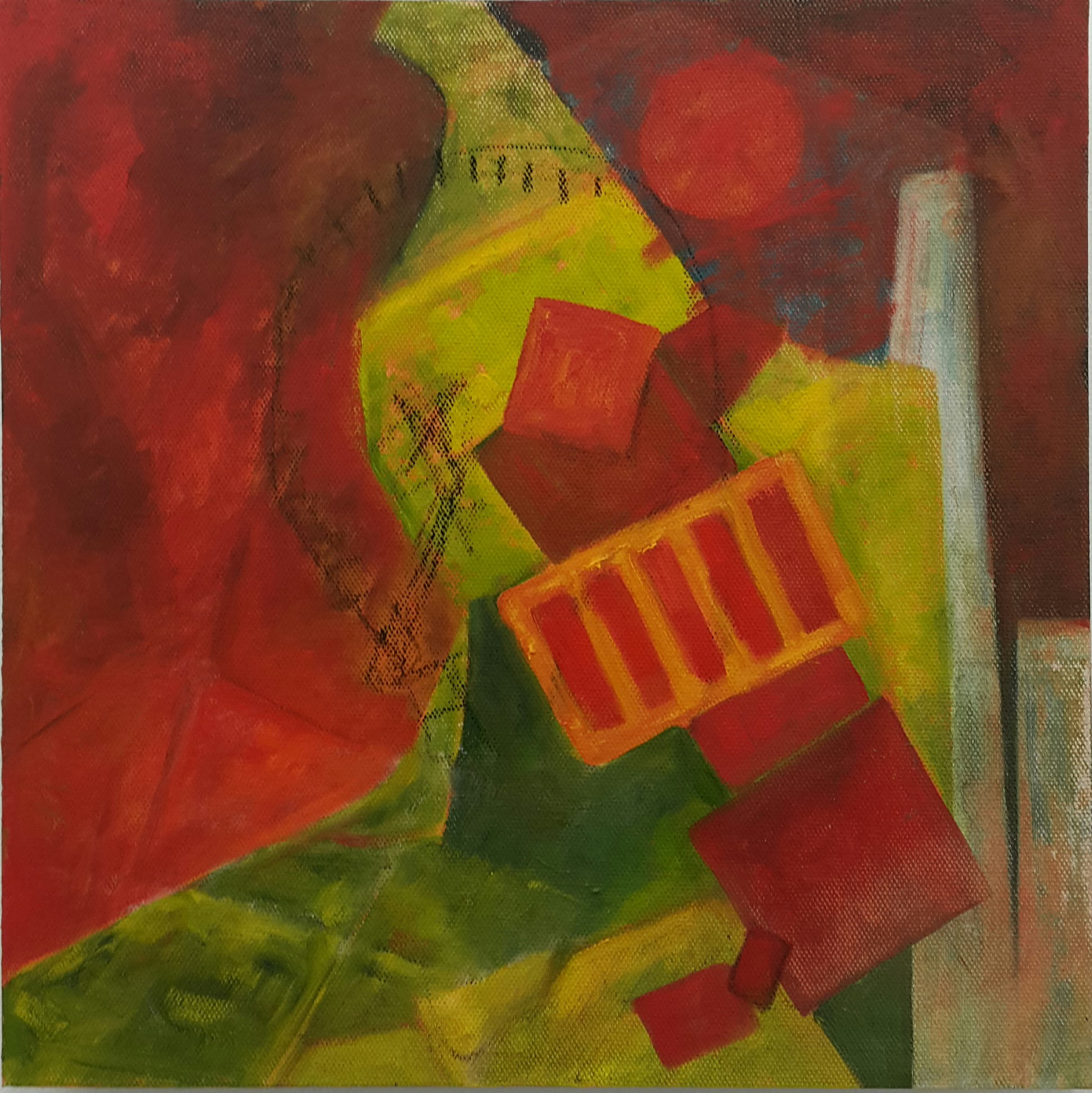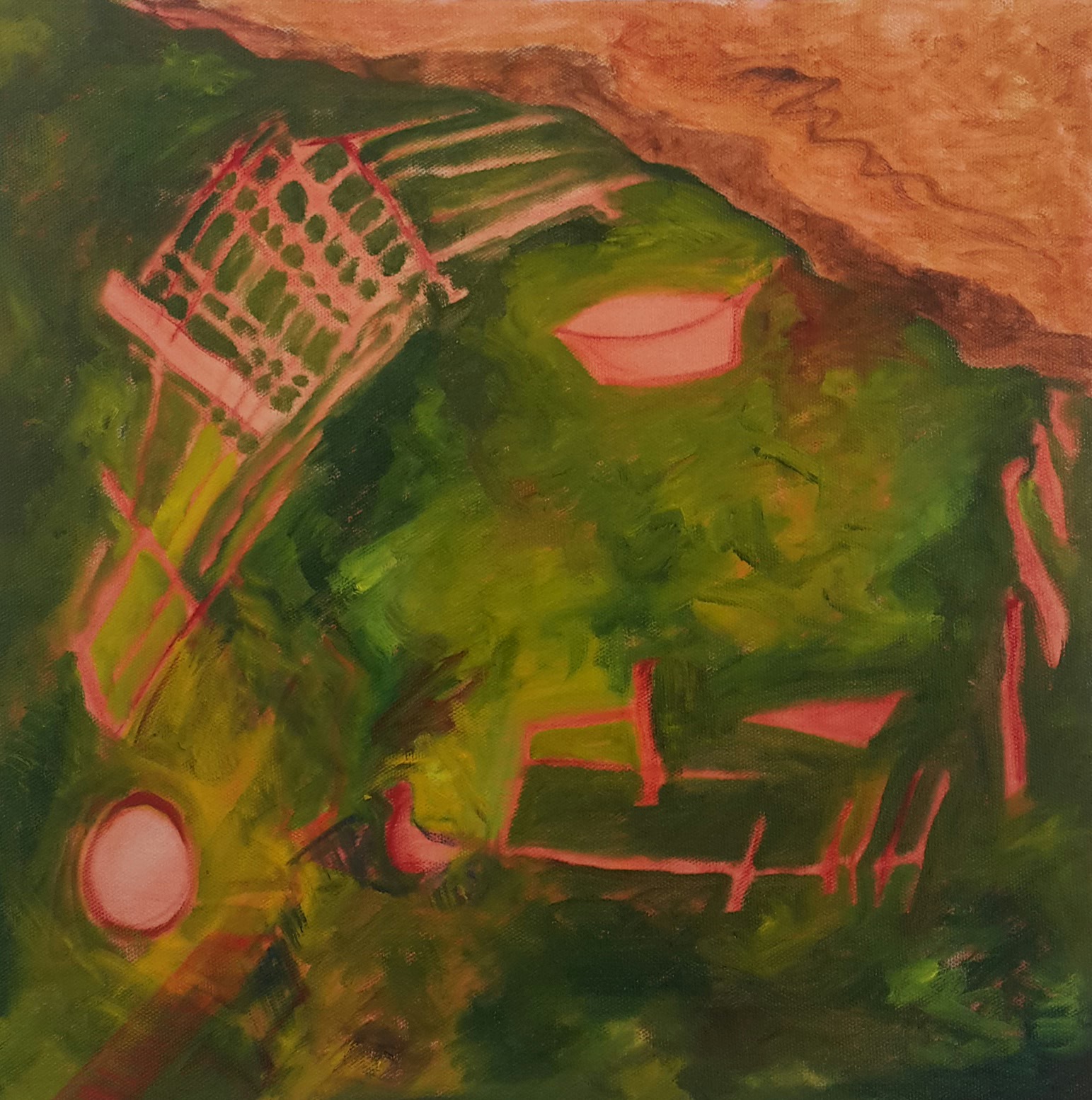John R. P. Hodgson
2017
BFA (Hons) Project
Re-imagining: Fragments of identity.
2017
BFA (Hons) Project
Re-imagining: Fragments of identity.

John Hodgson
“Kirikōpuni”, 2017
Oil and charcoal on stretched canvas
300x300mm, Private Collection
The Kirikōpuni Project
Recollections, the fuzzy side of memory where historical accuracy runs a distant second to mediated, selective filtering. Artefacts of remembering, comprising identity. Take a recollected real event, existing now only as prejudiced ephemera in the mind of the individual, make it real and tangible once again. Use colour and idiosyncratic form, gesture and line to present a recollection as a vista, a ‘scape’. Existence located now in a scape of present and recollected land, that deeply mediated perception of place, of origin - a contiguous past. ‘Home’ is the rightness of underlying forms in these scapes that survive the surface changes, a scape that is populated by instantly recognizable artefacts, fragments perhaps of buildings, land patterns, a roll of the hills, a twist in the street, a deep lush smell of vegetation in the rain, or the dry, that could only exist in this place. Now encompassingThen.
The ‘hooks’ on which viewers might be caught and reached became not just colour, line and composition but also the fuzziness of representation that, like recollection, tug at the corners of the mind to evoke and solidify a viewer’s own experiences and rememberings.
A concurrent thread in the project is the memories that one misses out on due to circumstances of cultural filtering. It was only through this project that I discovered my first school was a stone’s throw from a local marae. A marae where once an early missionary and a paramount chief collaborated to avoid a northern Maōri attack on colonial Auckland – for instance. A contemporary Maōri art historian’s[1] proposition that an understanding of Maōri ‘recollections’ of land use, events and place could be understood by applying the ancient notion of ‘palimpsest’, reading layers of concurrent overlapping remembrances each valid from different viewpoints, became important. Both as a way of reading ‘history’ and of building the material object, the painting. The recurring and layered motifs of river, a horseshoe bend on the Northern Wairoa (yellow, brown, muddy and full of eels), manuka scrub, rolling hills, waka (canoe) on the water, fires in the land – all these and more bridge the personal history of a small Pākehā child of the fifties, of the land, with the broader ancient and contemporary history of tangata whenua, the people of the land.
The Kirikōpuni series captures recollections of 1950s & 60s childhood, on a bend of the Northern Wairoa river at Kirikōpuni. Hay was still being made with standing balers and pitchforks to thatch the top of the stack. Such recollections persisting through the years underpin present identity.
[1] Dr Rangihiroa Panoho

John Hodgson
"Kirikopuni - Wigwam For a Goose's Bridle", 2017
Oil on stretched canvas
300x300mm, Available
There was always something for the kids, a scone, a story, a smarting slap on the bum when earned. And to the eternal question, "What's that mum?", often the answer was, "A wigwam for a goose's bridle”.

John Hodgson
"Kirikopuni - Making Hay, Pear Tree Paddock”, 2017
Oil on stretched canvas
300x300mm, Wallace Art Collection
I got to carry the tea billy. The men shut the tractors and baler down for morning scones. We were not allowed through the gate while they were working. Big belts and whirling pulleys, man could that big red machine dance as it punched the bales out. The tractor would squat and groan as the men forked the hay in and the big pivot bar came down each time to punch hay into the chamber. Golden hay, dust and the only shade under the old pear tree. Wasps got most of the fruit.

John Hodgson
"Kirikopuni - Red Sky Morning", 2017.
Oil and charcoal on stretched canvas
300x300mm, Available
The factories are still there, ruins now. Railway defunct, white gates gone. Town vanished and school demolished. The grill on the shiny new Bristol bully gleamed yellow - rusted now.

John Hodgson
"Kirikopuni - Burning Land", 2017
Oil on canvas on board
300x300mm, Available
A hand auger, a stick of jelly, and kaboom! the stumps fair flew out of the ground. Heaped up they burned for days, that wonderful smoke on the wind; kauri, totara, matai, kahikatea. "Breaking the land in", dad said. We burned it and now it seems we broke it too.

John Hodgson
"Kirikopuni - No Way Home", 2017
Oil on canvas on board
300x300mm, Collection of the Artist
The eels swarmed in the river around the sack of sheep guts. We hung them on the clothes line to skin. My Welsh grandparents were always keen on a feed of eel. They used to eat them at Home. My home was by the river, muddy brown and trains winding past the front farm gate. Long grass in the summer paddocks. Dirt roads. Far away now.

John Hodgson
"Kirikopuni - Free Range", 2017
Oil on canvas on board
500x500mm, Available
Down the back of the yard, near the winter river, the ducks and chooks scratched among the grass and weeds. The scraps cooked up with steaming mash smelled so good. The fences were pretty rickety but I climbed them anyway, didn’t spill the mash neither. Tipped it into the old enamel pot and the broke handle tub. The chooks came running and squawking. Rooster in charge. The ducks not so much. Maybe they knew I’d be sneaking their eggs.

John Hodgson
"Kirikopuni - Institutional Concrete", 2017
Oil on canvas on board
500x500mm, Wallace Arts Trust
Its just what we did really. The trains run no more, the dozer is derelict, the lonely brick chimney remembers where a house once stood. The concrete remains. Embedded in the land, form enduring, function forgotten. Palimpsests of occupation.

John Hodgson
"Kirikopuni - Landforms (II)", 2017
Oil on canvas on board
500x500mm, Available
We dug drains deep in the clay. At first we cut scrub to lay in the bottom to keep them open, with the spoil shovelled back in on top. They only stayed open a few years. With more grass we could buy tiles. Terracotta tubes dad placed end to end with a hunk of teatree trunk on the end of a long stick to hook them and ease them together. A super long hockey stick. He dug and tiled for days. Paddock after paddock. Rugged stuff. They came on a wagon on the rails to the train station, then trucked to the farm. Still buried there now. The paddocks look like neat parks today, scrub and logs and swamp all gone. But I know the tiles are still there.

John Hodgson
"Kirikopuni - Dargaville Summer", 2017
Oil on canvas on board
500x500mm, Collection of the Artist
The bridge crossed the muddy Northern Wairoa at Dargaville on the road to Arapohue: wooden planks, passing bays, gravel roads, Ford V8s and Humber Super Snipes. Grandma Vera made the swearing farmer back up to the passing bay, she was too scared to reverse. Mum egged her on. We bought icecreams.

John Hodgson
"Kirikopuni - Glory Days", 2017
Oil on canvas on board
500x500mm, Available
Gordon Coates' pork barrel. It pays to have a Prime Minister as your MP. We walked across his Kirikopuni rail loop at the neck of the farm on the way to school, double white gates and Maori workmen on hand-pumped jiggers. Dad sold them pigs. They worked real hard. We walked for miles in the summer heat and dust.

John Hodgson
"Kirikopuni - And you my father", 2017
Oil on canvas on board
1200x1200mm, Available
A world of machinery, railroads and paddocks with the summer heat shimmering and the thistle down endlessly blowing, scooting along the summer skies.

John Hodgson
"Kirikopuni, 1960 - Making Hay: Storm", 2017-2019
Oil on canvas on board
1200x1200mm, Collection of the Artist
Childhood summers were endless. Haymaking then was late December into January and even February some years. We still built stacks in the paddock with small bales, the stack thatched on top with loose hay pitched up with long handled, long-tine forks. One time a storm came, hay and heat blew everywhere. Dust and hayseed runnels, shower driven, filming the windscreen of the Ford Prefect bringing afternoon tea. The rain was brief and fresh, whipped away with the wind, but I could smell it. Smell the heat and the rain. I thought the stack would blow away - it was huge, big as a house really. I chased after armloads of loose hay scurrying ahead of me on the hillside. Dad and the men were putting a tarp with ropes over the stack to keep the thatch on. It flapped and cracked in the wind. It was a big storm. Seeds and dust and rain caught in my throat. It was fun. I pressed my nose against the bedroom window that night wondering if the stack had blown away yet. I was a hero at morning talk.